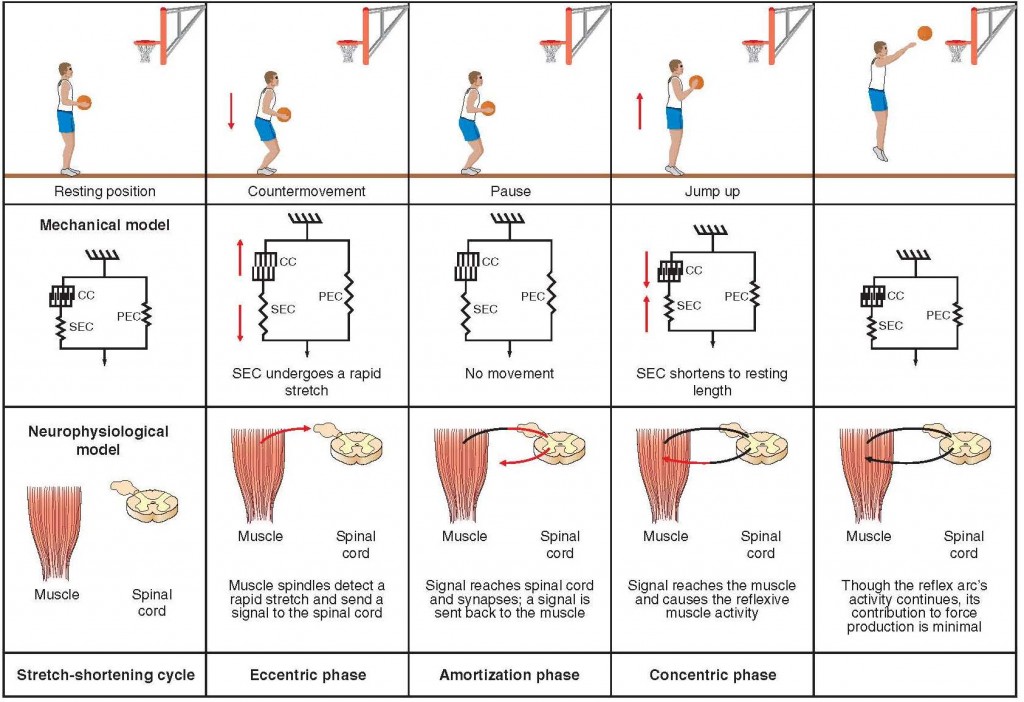
The Stretch Shortening Cycle (SSC) employs the energy storage capabilities of the elastic components (SEC) and stimulation of the stretch reflex to facilitate a maximal increase in muscle recruitment over a minimal amount of time. The SSC involves three distinct phases
- Phase I is the eccentric phase, which involves preloading the muscle group(s). During this phase, the SEC stores elastic energy, and the muscle spindles are stimulated. As the muscle spindles are stretched, they send a signal to the spinal cord. To visualize the eccentric phase, consider the long jump. The time from touchdown of the foot to the bottom of the movement is the eccentric phase.
- Phase II is the time between the eccentric and concentric phases and is termed the amortization—or transition—phase. This is the time from the end of the eccentric phase to the initiation of the concentric muscle action. There is a delay between the eccentric and concentric muscle actions. The nerves transmit signals to the muscle group. This phase of the SSC must be kept short. If the amortization phase lasts too long, the energy stored during the eccentric phase dissipates as heat, and the stretch reflex will not increase muscle activity during the concentric phase. Consider the long jumper mentioned previously. Once he or she has touched down and movement has stopped, the amortization phase has begun. As soon as movement begins, the amortization phase has ended.
- The concentric phase, phase III, is the body’s response to the eccentric and amortization phases. During this phase, the energy stored in the SEC during the eccentric phase either is used to increase the force of the subsequent movement or is dissipated as heat. This stored elastic energy increases the force produced during the concentric phase movement beyond that of an isolated concentric muscle action. In addition, the alpha motor neurons stimulate the muscle group, resulting in a reflexive concentric muscle action (i.e., the stretch reflex). The efficiency of these subsystems is essential to the proper performance of plyometric exercises. Again visualize the long jumper. As soon as movement begins in an upward direction, the concentric phase of the SSC has begun and the amortization phase has ended. In this example, one of the involved muscles is the gastrocnemius. Upon touchdown, the gastrocnemius undergoes a rapid stretch (eccentric phase), there is a delay in movement (amortization phase), then the muscle concentrically plantar flexes the ankle, allowing the athlete to push off the ground (concentric phase).
The rate of musculotendinous stretch is vital to plyometric exercise. A high stretch rate results in greater muscle recruitment and activity during the SSC concentric phase. The importance of the stretch rate may be illustrated by three different vertical jump tests: a static squat jump, a countermovement jump, and an approach jump with several steps. As the rate of stretch increases, an athlete’s absolute performance in these tests improves; the static squat jump results in the lowest jump height and the approach jump, the highest. The static squat jump requires the athlete to assume a squatting position (i.e., 90° hip flexion and 90° knee flexion) followed by a jump up. This jump does not use stored elastic energy and is too slow to allow the stretch reflex to potentiate the jump because there is essentially no eccentric phase. The countermovement jump uses a rapid eccentric element (i.e., partial squat) followed immediately by rapid concentric muscle activity (i.e., jump up). The rapid eccentric phase allows the athlete to store (and use) elastic energy in the stretched musculotendinous unit and stimulates the stretch reflex, thereby potentiating muscle activity. The approach jump uses an even quicker, more forceful eccentric phase than the countermovement jump; the increased rate of stretch during the eccentric phase allows a further increase in vertical jump height.
(The above is adapted from a chapter I wrote for the NSCA’s Essentials of Strength Training and Conditioning.)
